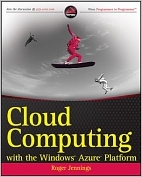| |||||
• polskie
• Zamów informacje o nowościach z wybranego tematu • kontakt |
CLOUD COMPUTING WITH THE WINDOWS AZURE PLATFORMJENNINGS R.wydawnictwo: WILEY, 2009, wydanie Icena netto: Leverage the power of the Azure Services Platform for cloud computing With the Azure Services Platform, processing and storing data moves from individual corporate servers and Web sites to larger, more reliable, and more secure data centers. Roger Jennings, author of more than 30 books on Microsoft technologies, shows you how to leverage the power of Azure and its related services for cloud computing. The book begins with a look at the differences between cloud computing and application hosting and examines the various issues that .NET developers and IT managers face in moving from on-premise to cloud-based applications, including security, privacy, regulatory compliance, backup and recovery, asset cataloging, and other common technical issues. The author then drills down, showing basic programming for individual Azure components, including storage, SQL Data Services, and .NET Services. He then moves on to cover more advanced programming challenges.
Roger Jennings clears away the clouds and gets you started using the Azure Services Platform. Table of Contents
Introduction. Part I: Introducing the Windows Azure Platform. Chapter 1: Surveying the Role of Cloud Computing. Chapter 2: Understanding Windows Azure Platform Architecture. Chapter 3: Analyzing the Windows Azure Operating System. Chapter 4: Scaling Azure Table and Blob Storage. Part II: Taking Advantage of Cloud Services in the Enterprise. Chapter 5: Minimizing Risk When Moving to Azure Cloud Services. Chapter 6: Authenticating and Authorizing Service Users. Chapter 7: Optimizing the Scalability and Performance of Azure Tables. Chapter 8: Messaging with Azure Queues. Part III: Tackling Advanced Azure Services Techniques. Chapter 9: Authenticating Users with .NET Access Control Services. Chapter 10: Interconnecting Services with the .NET Service Bus. Chapter 11: Exploring .NET Service Bus Queues and Routers. Part IV: Working with SQL Azure Services (Online Only). Chapter 12: Managing SQL Azure Accounts, Databases, and DataHubs. Chapter 13: Exploiting SQL Azure Database's Relational Features. Index. 360 pages, Paperback
Po otrzymaniu zamówienia poinformujemy pocztą e-mail lub telefonicznie, |


